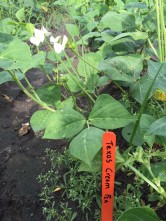Peas In Our Time




 The cowpea is about to have its moment. This fall, thanks to the efforts of culinary historian David Shields, horticulturalists Brian Ward and Richard Fery, and chefs Kevin Mitchell and Benjamin Dennis, an historic array of traditional varieties of cowpeas will be set alongside one another for comparison by southern pea aficionados.
The cowpea is about to have its moment. This fall, thanks to the efforts of culinary historian David Shields, horticulturalists Brian Ward and Richard Fery, and chefs Kevin Mitchell and Benjamin Dennis, an historic array of traditional varieties of cowpeas will be set alongside one another for comparison by southern pea aficionados.
Never has such a variety of peas been grown and tested for taste. Not since George Washington Carver’s  work at Tuskegee in the last century have peas been given such loving attention. The impetus for the pea tasting came as we at Red Dirt Productions were exploring ways to communicate the rich complexity of the Southern pea to an audience outside the South. Early in our researches for our documentary At the Common Table, we read an account of such a pea tasting by April McGreger, one of our culinary heroes. In North Carolina, April had rounded up thirteen varieties along with their pot likker for probing.
work at Tuskegee in the last century have peas been given such loving attention. The impetus for the pea tasting came as we at Red Dirt Productions were exploring ways to communicate the rich complexity of the Southern pea to an audience outside the South. Early in our researches for our documentary At the Common Table, we read an account of such a pea tasting by April McGreger, one of our culinary heroes. In North Carolina, April had rounded up thirteen varieties along with their pot likker for probing.
We are hoping to have nearly thirty, thanks to the work of the Clemson Coastal Research and Education Center Organic Research Farm outside of Charleston.  The classic varieties will be there—the Lady, the Pink-Eyed Purple Hull, Sea Island Red, the Whippoorwill, the Mississippi Silver Hull, the Brown Crowder, the Clay, The Rice, the White Acre, the Texas Cream, as well as more localized specialties such as South Carolina’s Rice Pea and Louisiana’s Black Crowder.
The classic varieties will be there—the Lady, the Pink-Eyed Purple Hull, Sea Island Red, the Whippoorwill, the Mississippi Silver Hull, the Brown Crowder, the Clay, The Rice, the White Acre, the Texas Cream, as well as more localized specialties such as South Carolina’s Rice Pea and Louisiana’s Black Crowder.



.jpg)


Cowpeas are important for their food value and even more, for the story they tell about Southern people and their connections to place and to one another. In telling the story of cowpeas, we also tell the story of the Africans who brought them here, of native Americans who quickly adopted them into their gardens, and of European colonists who recognized their nutritional values for livestock as well as human beings.
The story is one of extraordinary variety and complexity—both human and plant. A story with cruelty as well as cooperation. With sorrow as well as beauty. A story that will challenge much of what we know about the food on our plate and the stories of our past. The cowpea’s time has come.
















